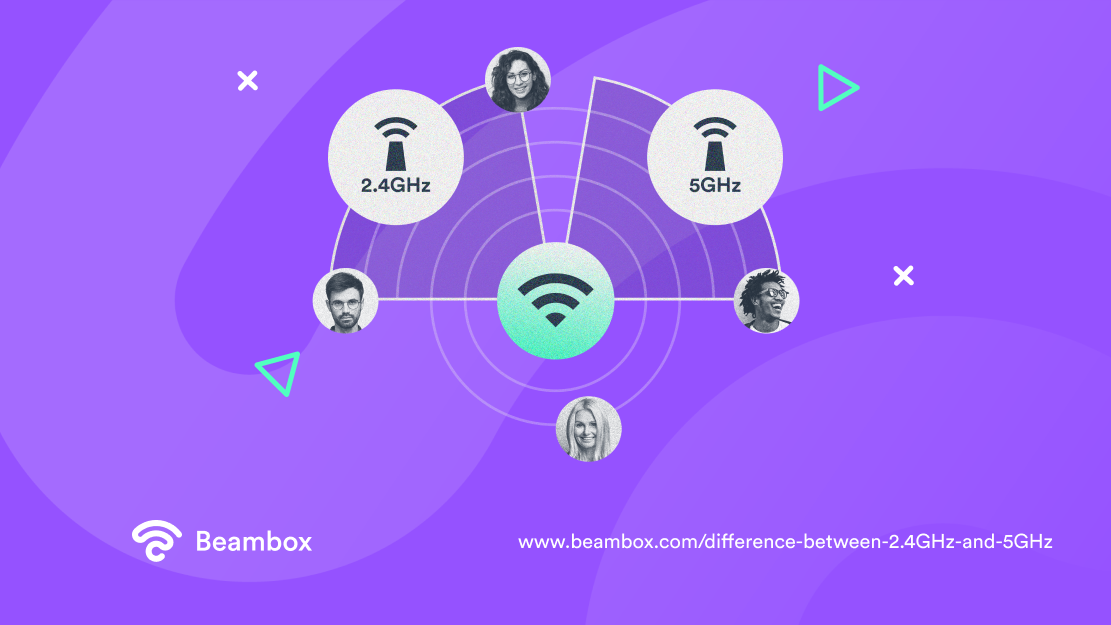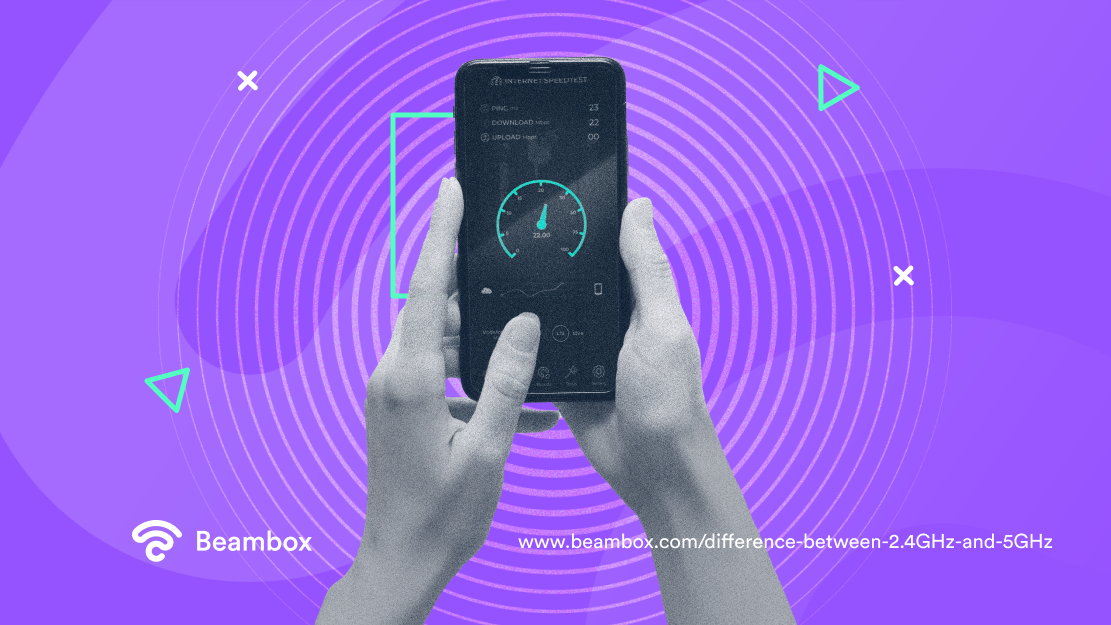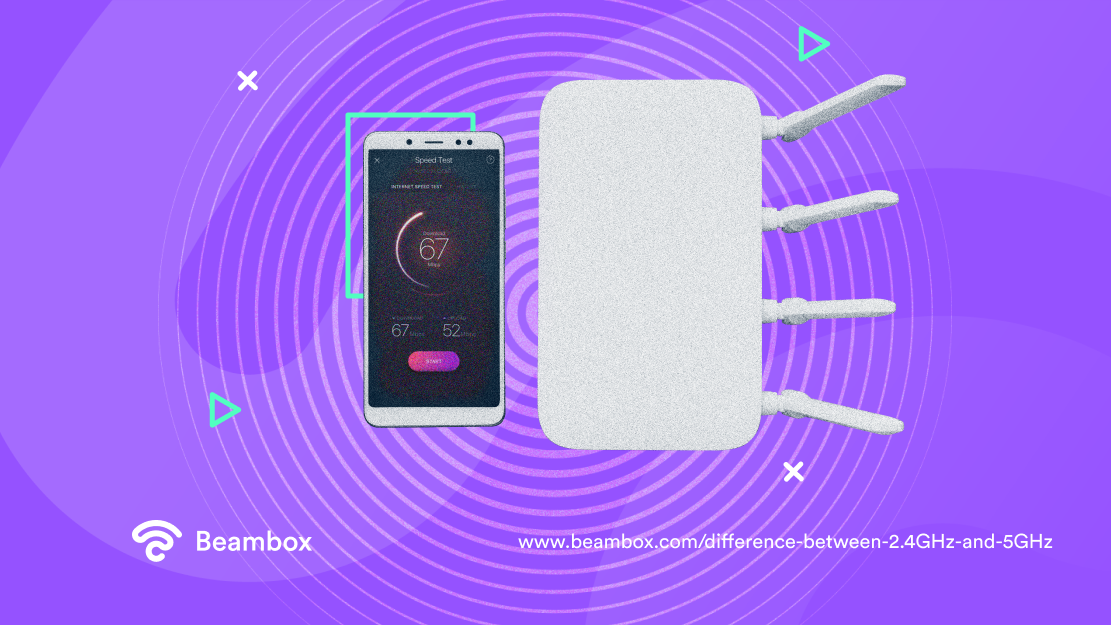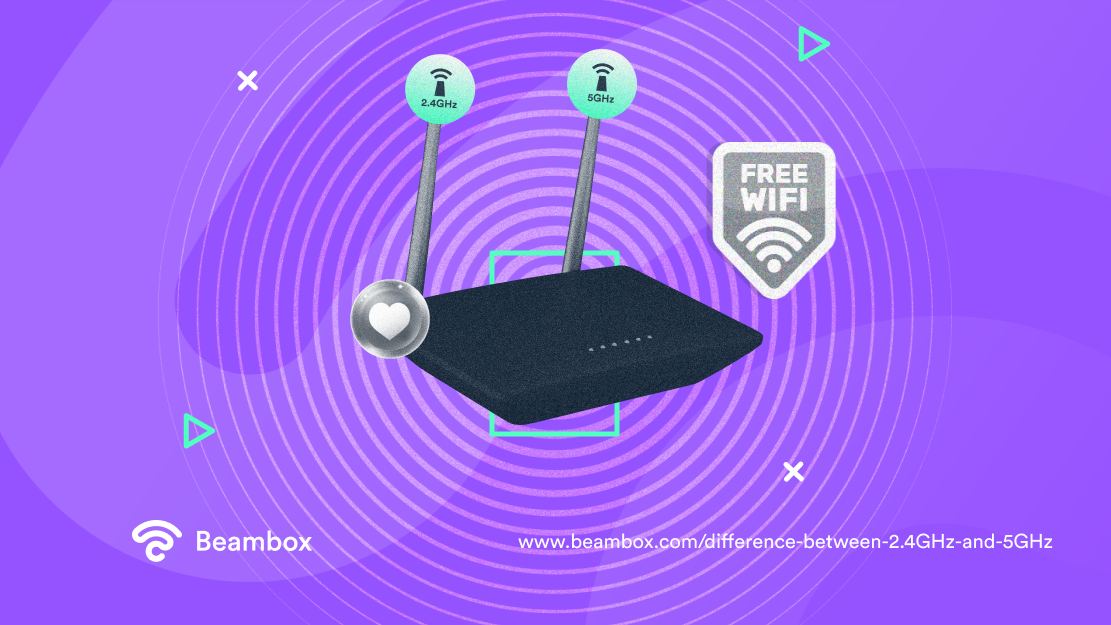Before you can select the right wifi for your small business, you need to know the basics. Like grasping the difference between 2.4 GHz vs 5 GHz WiFi (aka radio frequencies).
If you own a business offering guest WiFi, you need to know more than what a wireless router is. Or if you can have a lot of devices connected to your network. You need to know about Wi-Fi frequency bands.
Distinguishing between these standard wireless protocols helps you pick the best WiFi solution for your business and customers’ connectivity needs. You’ll know which option gives you the fastest speeds and that fits best into your business budget.
Why do all this? Because enhancing the guest wireless network experience is always good for business. Read on for our ultimate guide on all things 5GHz vs 2.4 GHz Wi-Fi.

What Is 2.4 Ghz Band vs 5Ghz?
If you’re wondering what 2.4 GHz band vs 5GHz is, these are both gigahertz. A gigahertz is a unit of measurement for frequencies. They usually gauge computer processing speed, alternating currents, and electromagnetic frequencies. In this case, Ghz measures wifi connection speed.
These numbers represent the two different “bands” or frequencies your WiFi router can use to connect with internet-enabled devices. Regarding WiFi, the difference between 2.4 GHz vs 5 GHz indicates the connectivity speed a router can support.
2.4 GHz devices include microwaves, most Bluetooth devices, pet and baby monitors, garage door openers, and similar objects. These objects typically have decent reception and speed but don’t handle interference the best.
5 GHz Wi-Fi and devices are newer, better at handling interference, and deliver faster speeds. They include most newer routers and phones.
You’ve got a general idea of these wireless standard protocols. Now, let’s dig deeper into the differences between the two.

When To Use 2.4 Ghz vs 5Ghz
When a device connects to the internet, you measure the transmission speed in Mbps (megabits per second) or broadband speed. Broadband is the bandwidth used for WiFi connections to enable high-speed internet access.
The FCC defines broadband internet as having a minimum of 25 Mbps download and 3 Mbps upload speeds. The higher the Mbps, the faster the data transmission and the quicker the online activity for different wireless devices.
Once you understand that, knowing when to use 2.4 GHz vs 5GHz WiFi makes sense. It depends on the speed and range you need it in.

Main Difference Between 2.4 vs 5 Ghz WiFi: Speed
Under ideal conditions, 2.4 GHz will support anywhere between 450 Mbps and 600 Mbps. 5 GHz will support up to 1300 Mbps. Let’s break down what that means for your business and the wireless devices trying to connect to your Wi-Fi frequencies.
-
The 2.4 GHz Wi-Fi uses longer waves. That means it’s better for carrying data across longer distances. Additionally, it’s better at taking on physical obstacles interference (aka, penetrating solid objects between a router and the device).
-
5 GHz band uses shorter waves. Therefore it carries data faster over shorter distances. However, it’s less able to penetrate solid objects.
So if you’re transmitting data over a long distance, i.e., the distance between your router and device, you should use the 2.4 GHz band for fast internet speed.
If you’re transmitting data over a short distance, the 5 GHz band radio frequencies will connect you faster. Typically, they go up to 1300 Mbps under ideal conditions.
You can use a repeater or access point to make up for the shortcomings of both connections. However, the maximum speed either band can support depends on the router you’re using and outside factors. (Think weather, buildings, and property ownership.)

2.4 Ghz vs 5 Ghz Range Differences
At this point, you should understand that 5 GHz Wi-Fi frequencies are faster than 2.4 GHz Wi-Fi frequencies. Even if you don’t know much about WiFi networks or the different wireless standard protocols. All you have to remember is: the more gigahertz cycles per second, the faster the connection.
However, that’s not the only marker to consider when choosing which to use for your restaurant. The next biggest question is the WiFi range. Keep reading to find out more.
2.4 Ghz WiFi Range Coverage
As mentioned above, the 2.4 GHz vs 5 GHz band also indicates data transmission distance. If your Wi-Fi needs to cover a larger area or an area with walls and other solid objects, then 2.4 GHz is the ideal choice. The 2.4 WiFi GHz range goes much farther than that of 5 GHz.
Without considering other external factors or major obstacles, many standard Wi-Fi routers operating on the 2.4GHz frequency can reach up to 150 feet indoors and 300 feet outdoors. The 2.4 GHz band will meet the needs of large retail stores and multi-level establishments, for example.
In these situations, you likely have fewer devices that need connecting.
5Ghz WiFi Range
The 5 GHz frequency has a shorter effective range. It’s best for locations with no physical obstructions and that span around one-third of the distances mentioned above.

Congestion and Wi-Fi Frequency
Another difference between 2.4 and 5 GHz WiFi can be observed in their respective levels of “congestion.” Network congestion refers to too many signals trying to travel through a particular wireless router or device. So what frequency band should you use to avoid wireless congestion?
Because of its wider effective range, the 2.4 GHz band is more crowded than the 5 GHz band. The former is also used by other devices, such as Bluetooth devices, microwave ovens, baby monitors, etc.
The heavier congestion in this band can decrease internet speed. With less congestion, the latter provides a speedier and more stable internet connection — under ideal conditions, of course.

The Price Difference Between Routers 2.4 GHz vs 5 GHz
Is budget a concern for your business? Then let’s discuss how that affects what router speed you should choose. Between 2.4 GHz vs 5 GHz WiFi, 2.4 GHz is the cheaper option.
They’re older. And while they’re still an effective Wi-Fi method, they’re no longer cutting-edge. These days, people call 5 GHz Wi-Fi frequency bands “the next-gen WiFi standard” or “the standard.”
5 GHz packages are a newer offering in the market and provide considerably better speeds under certain conditions.
If you’re looking for more value for your money, you should spring for a 5 GHz WiFi package. Most modern routers already act as a dual-band, meaning the router can support both the 2.4 and 5 GHz bands. Some dual-band routers only allow the use of one frequency at a time. That means you’ll have to switch from 2.4 GHz to 5 GHz manually and vice versa, depending on your needs.
Another option is a simultaneous dual-band router, which simultaneously and separately broadcasts both 2.4 GHz and 5 GHz Wi-Fi frequencies. This way, you decide when you’ll get more bang for your buck based on you and your customer’s connectivity needs.

2.4 vs 5 Ghz WIFI: Which Is Better for Your Devices?
The battle between 2.4 vs 5 GHz WiFi can go either way, given the variety of factors determining internet conditions. The 2.4 GHz Wi-Fi has been around longer, but the speed of 5 GHz Wi-Fi might be the future of WiFi.
Wondering whether or not you should upgrade to a 5 GHz frequency to better serve your customers’ connectivity needs? Then here are a few more points to keep in mind when deciding between 2.4 GHz vs 5 GHz.
-
Think about your business model, layout and demand. At the end of the day, all you need is an excellent wireless connection. What does that look like for your company? 5 Ghz works great for WiFi for a small cafe or restaurant. If you have an open floor plan and a lot of guests using it for work, this is ideal. Or if you want to offer your establishment for business meetings and events.
-
Is your establishment in a crowded commercial building with other paid or free wireless routers and 2.4 GHz devices? Then consider a 5 GHz band. It’ll give you more coverage and avoid issues like WiFi network interference and wireless congestion.
-
Let’s say you’re a hotel, and you have to provide a WiFi connection to individual rooms on different floors. In that case, the 2.4 GHz band remains the better option. You might not have the fastest connection, but you do have a better range at a cheaper price.
-
No matter which you choose, use a WiFi calculator to check the speed and range of your signal.

2.4 Ghz vs 5 Ghz: The Best WiFi Solution for Your Business in Terms of Guest Experience
Knowing the difference between 2.4 and 5 GHz WiFi can help drive more business to your establishment. Customers can go anywhere they like to enjoy free WiFi. To attract more customers, you should take every opportunity to provide the best guest WiFi experience possible.
Your WiFi system setup is another opportunity to give your business a greater competitive edge. Invest in a customizable WiFi system, like Beambox, and you can do more than provide free, fast internet to customers.
Beambox is a sophisticated WiFi marketing platform. It enhances the guest WiFi experience, boosts business, builds customer loyalty, manages your online reputation, and more.
Beambox offers many ways to make your WiFi network work to your advantage while meeting your customers’ connectivity needs. Entice customers to subscribe to your SMS marketing via a customized captive portal login.
Additionally, you can:
-
Limit WiFi access within specified physical parameters
-
Control download speeds and sizes
-
Prompt customers to leave an online review
-
Depending on your WiFi customization preferences
… no matter if you use 2.4 GHz vs 5 GHz. You’ll also get access to intelligent marketing tools to harness valuable customer data and better understand clients.
Leverage WiFi marketing and accelerate your business growth — start your Beambox free trial today!
Get Started With Free WiFi Marketing
Beambox helps businesses like yours grow with data capture, marketing automation and reputation management.
Sign up for 30 days free